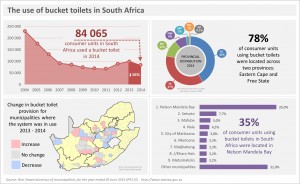
Bucket toilets: an update
The bucket toilet system remains a persistent phenomenon in seven of the nine provinces, despite measures to eradicate it. Where are bucket toilets still in use? And is South Africa succeeding in reducing its usage? Data from Stats SA’s latest Non-financial census of municipalities provides some insight into these questions.
Eastern Cape boasts largest decrease
There has been a drop in the use of bucket toilets nation-wide. Nationally 84 065 consumer units1 were serviced with bucket toilets in 2014, falling from 100 618 in 2013, and from 231 660 in 2004. The 16% drop in 2014 was driven mostly by municipalities in Eastern Cape who reduced the provincial total by 15 353 consumer units, from 50 266 in 2013 to 34 913 in 2014.
Bucket toilet usage also decreased in Free State and Western Cape.
The development of improved sanitation services was the main reason for the falling numbers, with municipalities replacing bucket toilets with other options, such as ventilated improved pit toilets, flush toilets, and septic tanks.
Despite the falling numbers, Eastern Cape and Free State remain the two provinces where bucket toilets are most common, with Eastern Cape contributing 42% to the national total, and Free State 37%.
In fact, just over a third of consumer units serviced with bucket toilets in South Africa are concentrated in a single municipality: Nelson Mandela Bay in Eastern Cape. In 2014 this metropolitan council provided bucket toilets to 29 429 consumer units, 35% of the national total.
Bucket toilets: a temporary measure
North West, Northern Cape and Mpumalanga experienced an increase in the provision of bucket toilets. This was mainly as a result of municipalities being forced to provide the option to rapidly growing informal settlements.
Bucket toilets are provided as a temporary solution while municipalities develop improved sanitation infrastructure. However, in some cases, the lack of funds to provide better facilities means that the problem of bucket toilets will not be eradicated overnight.
The seventh province where bucket toilets were recorded, Gauteng, experienced no change in usage between 2013 and 2014.
A municipal breakdown
Fifty-one South African municipalities provided bucket toilets to communities in 2014. One municipality, Tswaing in North West province, managed to eradicate bucket toilets entirely during the year. Two municipalities, Blue Crane in Eastern Cape, and Naledi in North West, adopted the use of bucket toilets after not having any in 2013.
Of the 51 municipalities:
- 13 municipalities reported a rise in municipal bucket toilet provision in 2014.
- 22 municipalities reported no change in bucket toilet provision.
- 16 reported a decrease in bucket toilet provision.
Download the 2014 Non-financial census of municipalities report here.
1 A consumer unit is an entity to which the service is delivered, and which receives one bill if the service is billed, alternatively known as a delivery point. This concept is often referred to as a household by municipalities, but this is not strictly correct, as households and consumer units do not coincide one to one, particularly in blocks of flats, on stands where there are multiple households in the same dwelling, or in additional dwellings, such as garden flats, backyard rooms, etc., and in the case of public taps.


